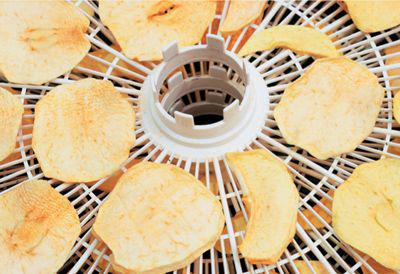DIY Projects for the Self-Sufficient Homeowner: 25 Ways to Build a Self-Reliant Lifestyle (20 page)
Authors: Betsy Matheson
Tags: #Non-Fiction

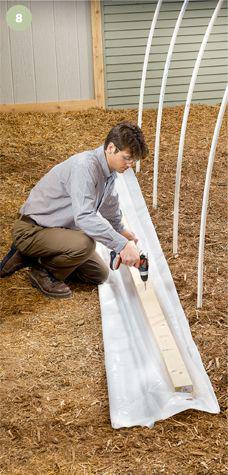
8 Lay a second 2 × 4
the same length as the first over the tacked plastic so the ends and edges of the 2 × 4s are flush. Drive a 2-1/2" deck screw through the top 2 × 4 and into the lower one every 24" or so, sandwiching the cover material between the boards. Lay the assembly next to one edge of the hoophouse and pull the free end of the material over the tops of the frames.
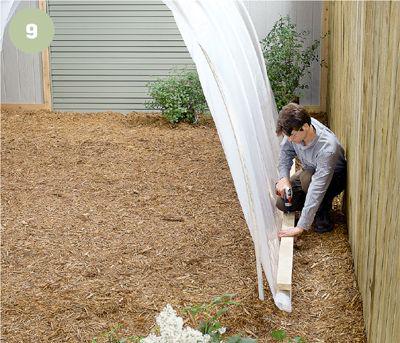
9 On the other side
of the structure, extend the cover material all the way down so it is taut and then position another 2 × 4 underneath the fabric where it meets the ground. Staple the plastic and then sandwich it with a final 2 × 4.
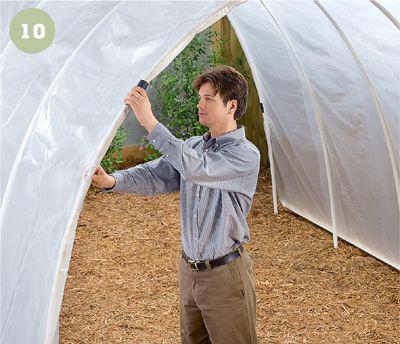
10 Make clips
to secure the roof cover material from a 12"-long section of hose or soft tubing. Here, 1"-dia., thin-walled PE supply tubing is slit longitudinally and then slipped over the material to clip it to the end frames. Use at least six clips per end. Do not clip at the intermediate hoop frames.
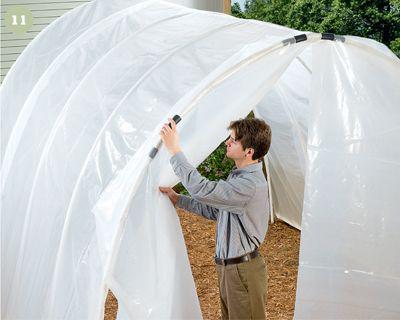
11
Option:
Make doors by clipping a piece of cover material to each end. (It’s best to do this before attaching the main cover.) Then cut a slit down the center of the end material. You can tie or tape the door material to the sides when you want it open and weigh down the pieces with a board or brick to keep the door shut. This solution is low-tech but effective.

Preserving garden produce does not need to be an overwhelming
task, but it is important to think through your strategy before you get started. To understand how to preserve food, it’s important first to understand why fresh fruits and vegetables spoil and decay. There are two main culprits: First, external agents, such as bacteria and mold, break down and consume fresh food. Second, naturally occurring enzymes—the very same ones that cause fruits and veggies to ripen—are also responsible for their decay. Canning, freezing, drying, and cold storage (along with salt-curing/smoking, and making fruit preserves) are all ways to slow down or halt these processes while retaining (to varying degrees) nutrition and taste.
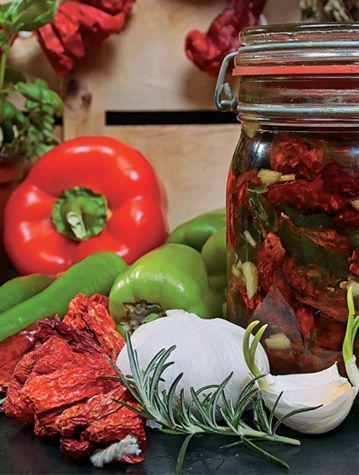
Canning is one
of the most popular forms of food preservation. The process is reliable and can be applied to a wide variety of vegetables.
Drying Produce
An electric food dehydrator is a fast, effective tool for drying fruit and vegetables. Because the produce is dried quickly in a closed environment, the process is very sanitary and yields consistent, predictable results.
Each method for preserving food has its strengths and weaknesses. It’s important to weigh these carefully and decide which preservation method is the best fit for your garden’s needs and your lifestyle.
Choosing the Best Preservation Method

Canning.
Canning changes the taste of foods and results in some vitamin loss, but is versatile and can be used to preserve many different kinds of foods for lengthy periods of time.
Cellaring.
Live storage preserves produce with minimal effect on taste or nutritional value, but it only makes sense for a few foodstuffs. The fruits and vegetables that can be cellared for limited periods of time require a storage environment that must be carefully regulated.
Freezing and drying.
Freezing and drying both retain a high percentage of vitamins and have a minimum effect on flavor, but only certain foods can be preserved with these methods and careful preparation and regulation is extremely important. Freezing can damage the cellular structure of fruits and vegetables, causing an unpleasant mushiness that makes them suitable only for dices and purees. Drying also changes the nature of fruits and vegetables; for example, drying fruits causes the caloric value to double or triple as the starches convert to sugars during the process.
 Preservation by Freezing
Preservation by Freezing